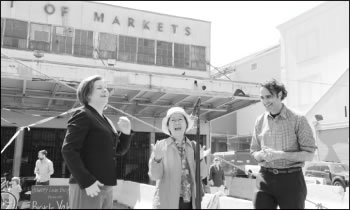BY Terese Loeb Kreuzer
In brilliant sunshine on Sun. May 1, City Council Speaker Christine Quinn and Councilmember Margaret Chin took turns ringing an old brass bell with a wooden handle to officially open the New Amsterdam Market for the 2011 season. The market’s founder, Robert LaValva, stood next to them, weary but smiling.
The New Amsterdam Market is on South Street in front of the stalls of the historic Fulton Fish Market, which moved to Hunts Point in the Bronx five years ago. LaValva has nurtured the New Amsterdam Market with single-minded passion and against obstacles that might have defeated someone less determined. Over the last five years the market has evolved from an experiment to a fixture. Vendors from Maine to Maryland and points in between have been coming with regional produce and products, oblivious perhaps, to LaValva’s ongoing bouts with real estate developers, who have wanted to use the South Street space for other purposes such as high-rise, luxury apartment buildings and hotels.
The May 1 market was supposed to be the first of this year’s weekly Sunday markets. As it turns out, it won’t be. Construction on the nearby Brooklyn Bridge has created an impediment because the space formerly used for the market between Beekman Street and Peck Slip now has to be used for parking. LaValva is having conversations with the City’s Economic Development Corporation to find a way to resolve the conflict. He expects to start up the weekly markets beginning Sunday, June 5.
“I don’t know exactly how,” said LaValva, “but I don’t have any reason to feel that we won’t be able to do it. No one has said to us that we can’t do it. We needed time to work it out. That’s why we decided to give it until June.”
Speaker Quinn has been an enthusiastic supporter of the market. “I think a goal of the neighborhood and the goal of the Council is to make this into a 12-month-a-year food market,” she said. “Eventually I’d like to see this market be both outside and inside. It could have a demonstration kitchen and could be a huge bonanza for the neighborhood and also an important tourist draw.”
Quinn admitted that the realization of this vision could be “a little challenging” however she said she was “optimistic about moving this idea forward to fruition.”
Following the bankruptcy of General Growth Properties in 2010, a spin-off company, Howard Hughes Corp., acquired G.G.P.’s lease on the South Street Seaport. Quinn said her staff would be meeting with Howard Hughes representatives “in the next week or so.”
“We’re going to push hard for a plan that we think will make them money and be the best for the City and the neighborhood and that would be a market like Pike Place Market [in Seattle],” she said.
That market, which dates from 1907, now has more than 200 year-round commercial businesses, 190 craftspeople and around 100 farmers who rent tables by the day.
In her remarks after ringing the market’s opening bell, Quinn said to the shoppers, “Who knew that when you came today to buy arugula you would be making a profound political statement about the future of downtown Manhattan? But you are and we thank you very much.”
Margaret Chin just shrugged her shoulders when asked about how the Howard Hughes Corp.’s plans might impact the market. “Right now, it’s all just talk,” she said. “We’re here!”
Their official duties done, Quinn and Chin hurried off to do some food shopping.























